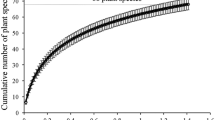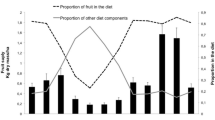Abstract
We studied the comparative feeding ecology of three species of colobus (Procolobus badius, Procolobus verus, and Colobus polykomos) on Tiwai Island, Sierra Leone. We collected dietary data on each species by scan-sampling habituated groups. Because these groups were observed in the same study area during overlapping time periods, the confounding effects of temporal and spatial variability in food availability were reduced. Our results show that the annual diets of the two larger species (Procolobus badius and Colobus polykomos) include roughly equal proportions of fruits (including seeds), young leaf parts, and mature leaf parts, although P. badius had a greater intake of floral parts. Procolobus verus consumed almost no mature leaf parts, few fruits and seeds, and many young leaf parts. Colobus polykomos commonly fed from lianas. Seeds were the dominant fruit item eaten by all three colobus, and the fruits they selected were generally dull and non-fleshy, in contrast to the brightly-colored, pulpy fruits eaten by guenons. Leguminous plants contributed substantially to the diets of both the larger species, but comparisons with other African forest sites indicate that colobine biomass is not closely correlated with the abundance of leguminous trees in the forest.
Similar content being viewed by others
REFERENCES
Altmann, J. (1974). Observational study of behavior: Sampling methods. Behaviour 49: 227–265.
Bauchop, T. (1978). Digestion of leaves in vertebrate arboreal folivores. In Montgomery, G. G. (ed.), The Ecology of Arboreal Folivores, Smithsonian Institution Press, Washington, D. C., pp. 193–204.
Bennett, E. L., and Davies, A. G. (1994). The ecology of Asian colobines. In Davies, A. G., and Oates, J. F. (eds.), Colobine Monkeys: Their Ecology, Behaviour and Evolution, Cambridge University Press, Cambridge, pp. 129–171.
Choo, G. M, Waterman, P. G., McKey, D. B., and Gartlan, J. S. (1981). A simple enzyme assay for dry matter digestibility and its value in studying food selection by generalist herbivores. Oecologia 49: 170–178.
Clutton-Brock, T. H. (1975). Feeding behaviour of red colobus and black and white colobus in East Africa. Folia Primatologica 23: 165–207.
Dasilva, G. L. (1989). The Ecology of the Western Black and White Colobus (Colobus polykomos polykomos Zimmerman 1780) on a Riverine Island in South-Eastern Sierra Leone, D. Phil. thesis, University of Oxford, Oxford.
Dasilva, G. L. (1992). The western black-and-white colobus as a low energy strategist: activity budgets, energy expenditure and energy intake. Journal of Animal Ecology 61: 79–91.
Dasilva, G. L. (1994). Diet of Colobus polykomos on Tiwai Island: Selection of food in relation to its seasonal abundance and nutritional quality. International Journal of Primatology 15: 655–680.
Davies, A. G. (1987). The Gola Forest Reserves, Sierra Leone:Wildlife Conservation and Forest Management, IUCN, Gland, Switzerland.
Davies, A. G. (1991). Seed-eating by red leaf monkeys (Presbytis rubicunda) in dipterocarp forest of northern Borneo. International Journal of Primatology 12: 119–144.
Davies, A. G. (1994). Colobine populations. In Davies, A. G. and Oates, J. F. (eds.), Colobine Monkeys: Their Ecology, Behaviour and Evolution, Cambridge University Press, Cambridge, pp. 285–310.
Davies, A. G., Bennett, E. L., and Waterman, P. G. (1988). Food selection by two South-East Asian colobine monkeys (Presbytis rubicunda and Presbytis melalophos) in relation to plant chemistry. Biological Journal of the Linnaean Society 34: 33–56.
Davies, A. G., Caldecott, J. O., and Chivers, D. J. (1984). Natural foods as a guide to nutrition of Old World primates. In Remfry, J. (ed.), Standards in Laboratory Animal Management, Universities Federation for Animal Welfare, Potters Bar, UK, pp. 225–244.
Galat, G., and Galat-Luong, A. (1985). La communaute de primates diurnes de la foret de Tai, Cote d'lvoire. Revue d'Ecologie (Terre Vie) 40: 3–32.
Gartlan, J. S., McKey, D. B., Waterman, P. G., Mbi, C. N., and Struhsaker, T. T. (1980). A comparative study of the phytochemistry of two African rainforests. Biochemical Systematics and Ecology 8: 401–422.
Gatinot, B. L. (1977). Le regime alimentaire du colobe bai au Senegal. Mammalia 41: 373–402.
Gautier-Hion, A. (1980). Seasonal variations of diet related to species and sex in a community of Cercopithecus monkeys. Journal of Animal Ecology 49: 237–270.
Gautier-Hion, A. (1983). Leaf consumption by monkeys in western and eastern Africa: A comparison. African Journal of Ecology 21:107–113.
Gautier-Hion, A., Duplantier, J. M., Quris, R., Feer, F, Sourd, C., Decoux, J.-P, Dubost, G., Emmons, L., Erard, C., Hecketsweiler, P., Moungazi, A., Roussilhon, C., and Thiollay, J.-M. (1985). Fruit characters as a basis of fruit choice and seed dispersal in a tropical forest vertebrate community. Oecologia 65: 324–337.
Gautier-Hion, A. Gautier, J. P., and Maisels, F. (1993). Seed dispersal versus seed predation: an intersite comparison of two related African monkeys. Vegetatio 107: 237–244.
Gautier-Hion, A., Gautier J.-P, Moungazi, A. (1997). Do black colobus in mixed-species groups benefit from increased foraging efficiency? Comptes Rendus Acadamie des Science, Paris: Sciences de la vie 320: 67–71.
Goltenboth, R. (1976). Non-human primates (apes, monkeys and prosimians). In Klos, H.-G., and Lang, E. M. (eds.), The Handbook of Zoo Medicine (translation), Van Nostrand Reinhold, New York, pp. 46–85.
Harrison, M. J. S. (1986). Feeding ecology of black colobus, Colobus satanas, in central Gabon. In Lee, P. C., and Else, J. G. (eds.), Primate Ecology and Conservation, Cambridge University Press, Cambridge, pp. 31–37.
Harrison, M. J. S., and Hladik, C. M. (1986). Un primate granivore: Le colobe noir dans la foret du Gabon; potentialite d'evolution du comportement alimentaire. Revue d'Ecologie (Terre Vie) 41:281–298.
Hill, C. M. (1991). A Study of Territoriality in Cercopithecus diana. Do Females Take an Active Part in Territorial Defence?, PhD dissertation, University of London.
Hladik, C. M. (1977). A comparative study of the feeding strategies of two sympatric spceies of leaf monkeys: Presbytis senex and Presbytis entellus. In Clutton-Brock, T. H. (ed.), Primate Ecology: Studies of Feeding and Ranging Behaviour in Lemurs, Monkeys and Apes, Academic Press, London.
Hoppe, P. P. (1977). Rumen fermentation and body weight in African ruminants. In Peterle, T. J. (ed.), Proceedings of the 13th Congress of Game Biologists, Atlanta, Wildlife Society, Washington, DC, pp. 141–150.
Hylander, W. L. (1979). The functional significance of primate mandibular form. Journal of Morphology 160: 223–240.
Janzen, D. H. (1975). Ecology of Plants in the Tropics, Edward Arnold, London.
Kay, R. N. B., and Davies, A. G. (1994). In Davies, A. G., and Oates, J. F. (eds.), Colobine Monkeys: Their Ecology, Behaviour and Evolution, Cambridge University Press, Cambridge, pp. 229–249.
Maisels, F., and Gautier-Hion, A. (1994). Why are Caesalpinoideae so important for monkeys in hydromorphic rainforest in the Zaire Basin? In Brent, J. I., and McKey, D. (eds.), Advances in Legume Systematics 5: The Nitrogen Factor, Royal Botanic Gardens, Kew, pp. 189–204.
Maisels, F., Gautier-Hion, A., and Gautier, J. P. (1994). Diets of two sympatric colobines in Zaire: More evidence on seed-eating in forests on poor soils. International Journal of Primatology 15:681–701.
McKey, D. (1978a). Plant Chemical Defenses and the Feeding and Ranging Behavior of Colobus Monkeys in African Rainforests, PhD dissertation, University of Michigan, Ann Arbor.
McKey, D. (1978b). Soils, vegetation, and seed-eating by black colobus monkeys. In Montgomery, G. G. (ed.), The Ecology of Arboreal Folivores, Smithsonian Institution Press, Washington, DC, pp. 423–437.
McKey, D., Gartlan, J. S., Waterman, P. G., and Choo, G. M. (1981). Food selection by black colobus monkeys (Colobus satanas) in relation to plant chemistry. Biological Journal of the Linnaean Society 16: 115–146.
Oates, J. F. (1977). The guereza and its food. In Clutton-Brock, T. H. (ed.), Primate Ecology: Studies of Feeding and Ranging Behaviour in Lemurs, Monkeys and Apes, Academic Press, London, pp. 275–321.
Oates, J. F. (1988). The diet of the olive colobus monkey, Procolobus verus, in Sierra Leone. International Journal of Primatology 9: 457–478.
Oates, J. F. (1994). The natural history of African colobines. In Davies, A. G., and Oates, J. F. (eds.), Colobine Monkeys: Their Ecology, Behaviour and Evolution, Cambridge University Press, Cambridge, pp. 75–128.
Oates, J. F., Swain, T., and Zantovska, J. (1977). Secondary compounds and food selection by colobus monkeys. Biochemical Systematics and Ecology 5: 317–321.
Oates, J. F., Waterman, P. G., and Choo, G. M. (1980). Food selection by the South Indian leaf-monkey, Presbytis johnii, in relation to plant chemistry. Oecologia 45: 45–56.
Oates, J. F., and Whitesides, G. H. (1990). Association between olive colobus (Procolobus verus), Diana guenons (Cercopithecus diana), and other forest monkeys in Sierra Leone. American Journal of Primatology 21: 129–146.
Oates, J. F., Whitesides, G. H., Davies, A. G., Waterman, P. G., Green, S. M., Dasilva, G. L., and Mole, S. (1990). Determinants of variation in tropical forest primate biomass: New evidence from West Africa. Ecology 71: 328–343.
Savill, P. S., and Fox, J. E. D. (1967). Trees of Sierra Leone, Forestry Department, Freetown, Sierra Leone.
Sourd, C., and Gautier-Hion, A. (1986). Fruit selection by a forest guenon. Journal of Animal Ecology 55: 235–244.
Starin, E. D. (1991). Socioecology of the Red Colobus Monkey in the Gambia with Particular Reference to Female-Male Differences and Transfer Patterns, PhD dissertation, City University of New York, New York.
Struhsaker, T. T. (1975). The Red Colobus Monkey, Chicago University Press, Chicago.
Struhsaker, T. T., and Oates, J. F. (1975). Comparison of the behavior and ecology of red colobus and black-and-white colobus in Uganda: A summary. In Tuttle, R. H. (ed.), Socioecology and Psychology of Primates, Mouton, The Hague, pp. 103–123.
van Soest, P. J. (1982). Nutritional Ecology of the Ruminant, O. & B. Books, Corvallis, Oregon.
Waterman, P. G., and Kool, K. M. (1994). Colobine food selection and plant chemistry. In Davies, A. G., and Oates, J. F. (eds.), Colobine Monkeys: Their Ecology, Behaviour and Evolution, Cambridge University Press, Cambridge, pp. 251–284.
Waterman, P. G., Ross, J. A. M., Bennett, E. L., and Davies, A. G. (1988). A comparison of the floristics and leaf chemistry of the tree flora in two Malaysian rain forests and the influence of leaf chemistry on populations of colobine monkeys in the old world. Biological Journal of the Linnaean Society 34: 1–32.
Whitesides, G. H. (1991). Patterns of Foraging, Ranging, and Interspecific Associations of Diana Monkeys (Cercopithecus diana) in Sierra Leone, West Africa. PhD dissertation, University of Miami.
Author information
Authors and Affiliations
Additional information
(Deceased)
Rights and permissions
About this article
Cite this article
Davies, A.G., Oates, J.F. & Dasilva, G.L. Patterns of Frugivory in Three West African Colobine Monkeys. International Journal of Primatology 20, 327–357 (1999). https://doi.org/10.1023/A:1020596503533
Issue Date:
DOI: https://doi.org/10.1023/A:1020596503533




